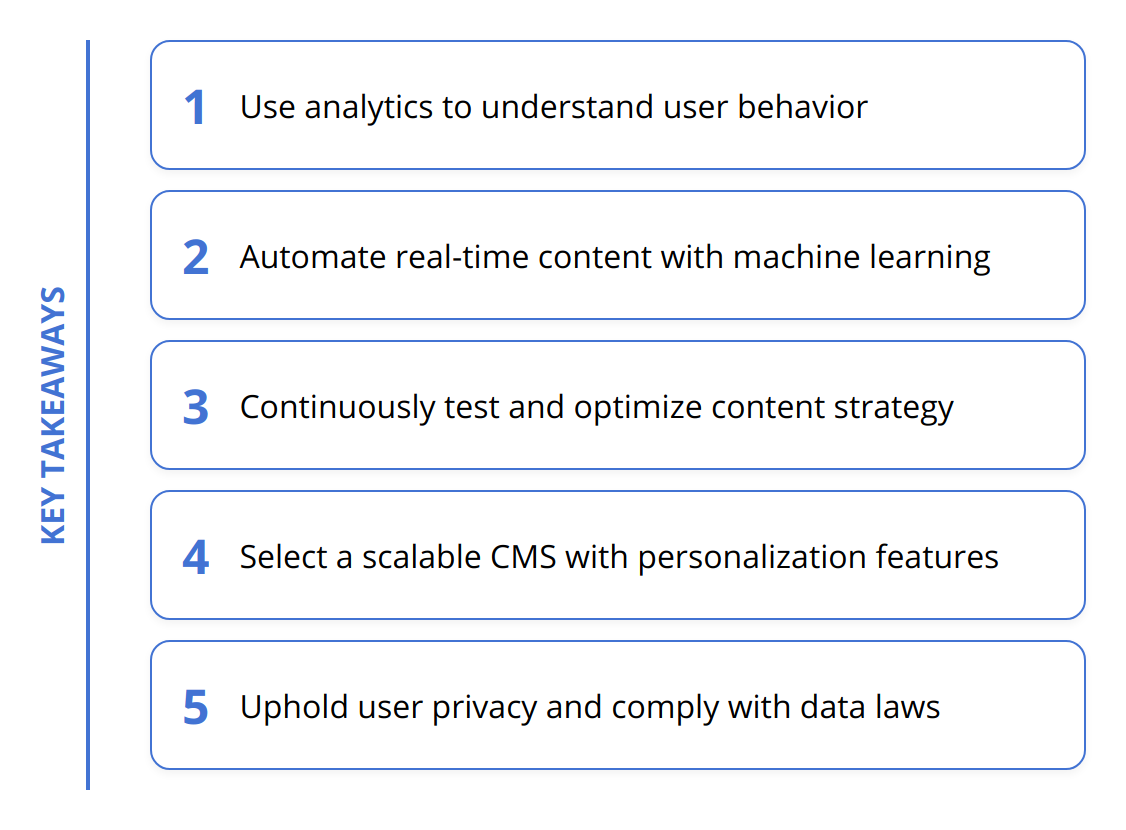Personalized content isn’t just a fleeting trend; it’s a defining factor of the modern digital experience. Users expect web interactions tailored to their preferences, behaviors, and needs.
We at Emplibot understand this expectation is a game-changer, pushing businesses to adopt dynamic content personalization strategies. Grasping best practices and technical considerations is imperative for those aiming to foster meaningful connections with their audience.
Contents
ToggleHow Does Dynamic Personalization Enhance UX?
Dynamic content personalization is akin to having a digital concierge for each user, one that understands preferences and behaviors to deliver a bespoke experience. It’s not a stretch to say dynamic personalization is revolutionizing the way businesses interact with users.
Personalization Mechanics
The engine behind dynamic content personalization revolves around algorithms and machine learning. These tech wizards analyze user data like browsing history, purchase records, and engagement metrics to predict future preferences. Simply put, a website can showcase products a customer is likely to buy or content that mirrors their interests. For instance, an ecommerce site might highlight running shoes to a visitor who frequently peruses sports gear.
Personalization Benefits
The benefits are clear and potent. Personalized experiences not only increase user satisfaction but also drive business metrics skyward:
-
Heightened engagement rates
-
Increased conversion rates
-
Strengthened customer loyalty
-
Reduced bounce rates
Moreover, personalized experiences feed into the continuity of user interactions, leading to a harmonious brand journey. According to a study by Epsilon, personalized emails boast 29% higher open rates and 41% higher click rates than their non-personalized counterparts. These stats make a solid case for personalized user experiences.

Fuel Your Strategy with Data
Any personalization strategy worth its salt is built on a bedrock of data. Without data, personalization is like shooting in the dark – ineffective and wasteful. Here are practical ways to harness data for dynamic content personalization:
-
Use analytics platforms to track user behavior on your site, illuminating paths and patterns.
-
Deploy customer relationship management (CRM) systems to consolidate user data for a 360-degree view.
-
Implement marketing automation tools that adjust content in real time, reacting to user interactions.
The imperative here is clear: personalization must be powered by accurate, comprehensive data. Employing tools like Google Analytics and CRM software can transform vast data sets into actionable insights.

For deeper exploration into leveraging analytics for personalization, consider our insights on marketing automation in data analytics.
In conclusion, personalization is non-negotiable for businesses vying for user attention in the digital arena. It’s emphatically a game-changer, paving the way for enhanced user experiences that translate to tangible business results. So, get on board with these best practices and watch as your brand resonance with users skyrockets.
Best Practices for Dynamic Personalization
Creating a seamless and tailored online experience is vital for customer satisfaction and business growth. To do this effectively, there are specific strategies and techniques you need to master. Let’s delve into how you can ace dynamic content personalization.
Harness Data While Respecting Privacy
Today’s savvy consumers are hyper-aware of their digital footprint and the value of their personal data. As you collect user information, it is essential to prioritize privacy and transparency. Here’s how to do it right:
-
Always obtain user consent before tracking their online behavior.
-
Secure user data with robust cybersecurity measures.
-
Clearly communicate how you’ll use the data to enhance user experience.
Focusing on these areas not only safeguards user data but also builds trust. When consumers trust you with their information, they’re more likely to engage with your brand.

Automate With Machine Learning
Machine learning is not just a buzzword—it’s the driving force behind intelligent content personalization. By automating the analysis of user data, you can:
-
Respond to user actions in real time with appropriate content.
-
Predict future behaviors and tailor content accordingly.
-
Identify patterns to offer more of what users like and less of what they don’t.
It’s about creating a dynamic space that feels like it’s continuously evolving, just like the interests and needs of your users.
Test, Learn, and Optimize
The digital world thrives on iteration, and personalization is no different. Utilize A/B testing to fine-tune your content for the best user experience:
-
Regularly test different versions of content to see what resonates with your audience.
-
Use these insights to adjust your content strategy and make data-driven decisions.
-
Consider both quantitative data like click-through and conversion rates and qualitative data such as user feedback.
Testing should be an ongoing process, as optimizing content is a never-ending pursuit in the quest to keep users engaged and convert browsers to buyers.

By implementing these best practices with a strong emphasis on data integrity, utilizing cutting-edge automation and committing to continuous improvement, businesses can create meaningful and effective personalization strategies that make users feel valued and understood.
Follow these tips and keep refining your approach. You’re on the right path to deliver exceptional personalized experiences that captivate your users and foster long-term loyalty.
The next chapter will build on these foundations to explore how you can apply dynamic personalization across various digital marketing channels for maximum impact.
Seamlessly Integrate CMS for Personalization
Navigating the technical landscape of content personalization requires skill and precision, ensuring that every digital interaction is as personalized as the handshake of a seasoned salesman. Trading static pages for a dynamic user experience marks a monumental step forward, but it demands careful integration with Content Management Systems (CMS) to lay the groundwork successfully. There’s a need to make certain that CMS acts in tandem with personalization engines, blending rich user data with content like a maestro conducting a symphony.
The best CMS platforms today come with in-built personalization capabilities or allow for smooth integration with third-party personalization engines. It means you can orchestrate a tailored experience without a hitch. For instance, platforms like Adobe Experience Manager have comprehensive tools that dovetail neatly with the personalization process. Moreover, a CMS with robust API support allows for pulling in data from multiple sources and pushing personalization rules seamlessly.
Here’s a practical tip: choose a CMS that can keep up with your ambitions and scale with your growth strategy. Examine its extensibility, compatibility with other systems, and ease of use to ensure it doesn’t become the bottleneck in your personalization efforts.
Meet Privacy Standards Head-On
The topic of privacy compliance is a minefield, and cutting corners isn’t an option when personal data is at play. Legislation like the General Data Protection Regulation (GDPR) and California Consumer Privacy Act (CCPA) aren’t just guidelines; they’re the law. Here’s the bread and butter of it: every business must walk the tightrope of personalizing content while upholding user privacy.
Compliance isn’t merely a checkbox; it takes a conscious commitment to user rights and data security. It involves enacting practices that put user consent at the forefront and demonstrating how their data seeds the personalization they benefit from. It’s also about ensuring that your personalization data pipeline is watertight against leaks and invasions.

It’s crucial to conduct regular audits and updates to your data handling practices. For those of you grappling with the intricacies of data privacy laws, an investment in tools like OneTrust can provide guidance and compliance assurance. When users see that you handle their data with care and respect, that trust translates to brand loyalty.
Ensure Performance While Scaling Up
Peering into the crystal ball of personalization, we find that preparing for scale is not just foresight; it’s foresight with eyes wide open. Ensuring scalability and performance means your platform remains quick on its feet, no matter how many users come knocking. The truth is, a lagging, cumbersome website drives away users faster than a pop-up on a 90s website.
Technical robustness must support the art of personalization. This involves selecting the right hosting environment, considering load balancing, having adequate caching strategies, and monitoring real-time performance actively. There’s no room for lethargy in web interactions. Sites like Shopify provide a solid foundation for e-commerce businesses looking to scale with unwavering uptime and seamless performance.
Here’s a bulletproof tactic: lean on Content Delivery Networks (CDNs) to swiftly serve personalized content from servers close to your users. They act as a distributed cache, slicing away at loading times and keeping user engagement sticky. Tools like Cloudflare stand out, pushing the boundaries of speed and security.
In sum, diving headlong into content personalization demands that your CMS remains pliable, your commitment to privacy unwavering, and the performance of your platform unmatched. These are the trampolines that will bounce your user engagement and loyalty rates sky-high. Technical diligence now creates a foundation for lasting digital relationships later.
Wrapping Up
Wrapping up the conversation on dynamic content personalization, we’ve navigated through the tactics that make each user feel like an honored guest rather than just another visitor. Personalization is more than a strategy; it’s a commitment to understanding and addressing unique customer needs on a mass scale. Businesses leaning into this approach see substantial rewards: stronger engagement, higher conversion rates, and enduring customer relationships.

Embracing data-driven platforms is necessary, but so is the protection of user privacy. Balancing tailored content with data security is not just smart—it’s paramount. Using robust analytics platforms and CRM systems, businesses can craft personalization strategies that resonate with users and abide by stringent privacy standards.
Beyond privacy, scalability ensures your personalization efforts don’t buckle under pressure. investing in the right technical infrastructure means your online environment is ready to grow as your audience does, maintaining performance and user satisfaction.
Here are the pillars to guide your personalization efforts:
-
Respect user privacy at every turn
-
Automate using machine learning for real-time responsiveness
-
Commit to testing, learning, and optimization
-
Choose CMS and tools that accommodate growth
-
Meet and exceed privacy standards
Adaptation is key: consumer behaviors and technologies evolve, and so should your personalization. Stay ahead by keeping a pulse on emerging trends and continuously refining your approach. After all, the landscape of digital interaction is ever-changing, and agility often separates the market leaders from the laggards.
For those ready to catapult their personalization strategies while also excelling in SEO and content creation, consider Emplibot to automatically publish SEO-friendly articles, complete with keyword research and internal linking, to your WordPress site. With Emplibot’s capabilities, you can build your blog without manual oversight, ensuring your content stays relevant and personalized.
Keeping everything we’ve discussed in mind, the final word is simple—be bold in your personalization efforts. The digital domain is your canvas, and with the right mix of innovation, empathy, and technology, you can paint a masterpiece that speaks directly to each unique visitor, leaving a lasting impression that keeps them coming back.










 Rated Excellent 4.5
Rated Excellent 4.5